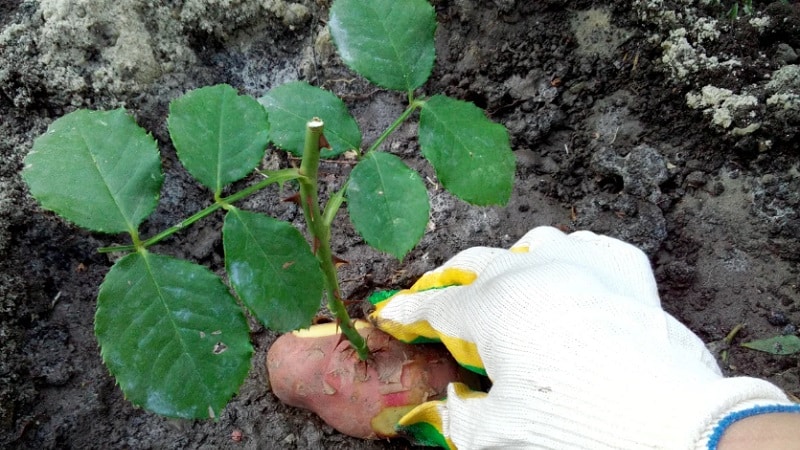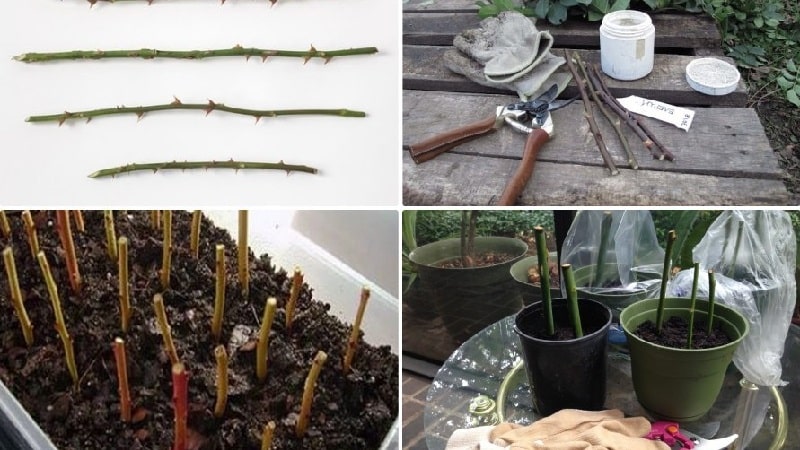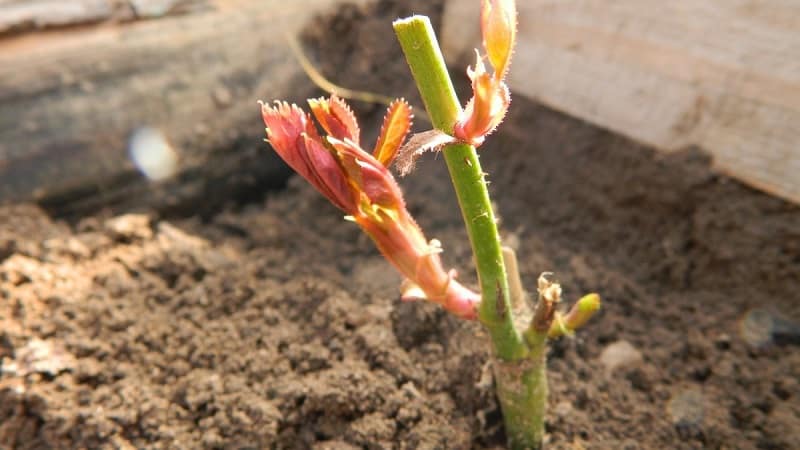How to properly carry out cuttings of roses in the summer in July: step-by-step instructions
Cutting roses in the summer in July is the optimal period for plant propagation. Green, fully leafy and flowering bushes produce a lot of young growth and allow you to preserve varietal characteristics. In this article we will talk in detail about whether it is possible to take cuttings from roses in the summer, what methods gardeners use to root cuttings and how to propagate them in open ground.
Is it worth propagating roses from cuttings in the summer in July?
Summer is the optimal time for cutting roses. It allows you to create young, healthy bushes and preserve the quality of the variety. For this, green cuttings are used, which appear in large numbers on the mother bushes in the summer.
There are no difficulties when choosing, because there is plenty of material for cuttings. During the summer cuttings root quickly and manage to gain strength before the onset of cold weather, and therefore winter without losses until the next season.
Advantages and disadvantages
Summer cuttings of rose bushes has a number of advantages over plant grafting:
- young bushes do not form root shoots;
- it is possible to propagate any variety and even roses from a given bouquet;
- easy to obtain planting material;
- bushes from cuttings live longer than grafted ones.
The disadvantage of this method is that to save young bushes have to be securely covered for the winter.

Optimal timing of the procedure
Cuttings of roses are recommended to be carried out in July - before and during flowering. In regions with hot and long summers, the procedure is extended until mid-August.
Favorable days according to the lunar calendar
Experienced gardeners advise cutting and rooting cuttings during the waxing moon.
Favorable dates in 2020:
- July - 1, 2, 4, 5, 21-23, 24, 29, 30;
- August - 1, 2, 20-26, 28-19.
Favorable days in 2021:
- July - 4, 7, 13-15, 19-23;
- August - 3, 5, 6, 10-12, 14, 15, 17-19.
Basic rules for cuttings
Young stems with bud buds are selected for cuttings.. To determine the age of the shoot, it is enough to break off several thorns: if they are easily separated, then the material is suitable for cutting.
The main mistake of gardeners - selection of stems that are too old or thin, the diameter of which exceeds 5 mm. Such material is difficult to take root.
It is recommended to select the part of the shoot located at the base. There should be 3-4 buds on it, directed in different directions. The lower cut is made at an acute angle between the thorn and the bud, 2-3 cm below it. The upper cut is made a maximum of 1 cm above the kidney. It can be flat or at an angle, since this does not in any way affect the degree of rooting of the cuttings. It is important to make it smooth and even. To do this, use sharply sharpened pruning shears that do not pinch or tear the stem.
The buds are partially trimmed, especially the lower ones. If you remove them completely, the cutting will be left without a power source. It is allowed to trim only leaves instead of leafy shoots.
Immediately after cutting, the cuttings are sent for rooting. It is not advisable to store them in the fresh air for a long period, otherwise they will dry out.
Interesting things on the site:
How to protect and treat roses in spring from diseases and pests
Step-by-step instructions for reproduction
Early morning is the most favorable time for taking rose cuttings, since the bushes are filled with moisture. A sharp pruner or knife is treated with medical alcohol, a solution of copper sulfate or potassium permanganate and the selected branches are divided into cuttings 12-15 cm long. They are cut from the middle part of the stem with 3-4 healthy buds. The leaves are completely removed or cut off by 1/3 to retain more moisture. The thorns are also carefully broken off.
Reference. Fattening green stems are not suitable for propagating roses by cuttings in summer. They can be recognized by the absence of buds.
After cutting, the material is soaked in a solution of “Epin”, “Zircon”, “Kornevin” or “Heteroauxin” to stimulate root growth. After this treatment, they appear after 2 weeks, with normal soaking in water - after a month. To stimulate root formation, a folk recipe is used: 20 drops of aloe juice or 1 tsp. honey per 250 ml of water.

Preparing the site for planting
Before you start planting rooted cuttings, you need to select a suitable area and prepare the soil on it. Fertile soil and a shaded area are suitable for planting roses..
Young plants must receive all the necessary microelements for normal development and be protected from the scorching sun. Flower growers recommend planting cuttings in the shade of trees or tall bushes.
The soil is loosened, weeds are removed, and sprinkled with turf-humus soil. (layer height - 10 cm), 3-5 cm of soil mixture of river sand and peat in a 1:1 ratio is placed on top.
Important! Compost and fresh manure are not used when planting cuttings. This feeding is suitable for mature plants, but young plants can rot.
The shoots are planted to a depth of 1.5-2 cm. Planting too deeply slows down rooting.The cuttings are covered with plastic bottles or glass jars to create a greenhouse effect. The area with seedlings is kept moist - the bushes are watered between shelters throughout the entire summer period.
Methods for rooting cuttings
Gardeners There are several ways to root rose cuttings.: in water, soil, potato tubers, plastic bag, burrito and Trannoy method.
In water
Cuttings 1-2 pcs. Place in transparent plastic or glass glasses or 200 ml jars. 2-3 cm of water is poured into containers and any growth stimulator is added. The container is placed on a bright windowsill, but not in direct sunlight. Water is added as it evaporates.
After the roots appear, the cuttings are planted in pots filled with ready-made soil mixture for roses. This rooting method is considered the most labor-intensive and has a minimal yield of seedlings.
In the ground
A small pot with a diameter of 8-10 cm is filled with soil for roses, make a 4 cm depression in the center, pour scalded vermiculite or sand into it to prevent rotting of the roots.
The tip of the cutting is dipped into a dry growth stimulator, planted in the ground and covered with a plastic bottle with the bottom cut off. The lid is periodically removed from the cap and water is poured into the pot. Blooming of the apical bud and young leaves indicates successful rooting of the cuttings. Now the cover can be removed and the seedlings can be sprayed with a spray bottle 2-3 times a day. The container is changed as the root system grows.
In potatoes
Rooting cuttings in potatoes is considered one of the most effective. The starch and nutrients contained in the tubers stimulate root growth. Medium-sized potatoes without rot or signs of infection are suitable.The tubers are soaked in a solution of “Strobi”, “Quadris”, “Horus”, “Delana”, “Acrobat” or “Ditan” to choose from, then all eyes are removed.

Sections of cuttings are treated with a solution of potassium permanganate, then immersed in aloe juice for 12 hours to better moisturize and preserve the freshness of the cuts. Instead of aloe, growth stimulants can be used.
Holes are cut in the tubers with a sharp knife. There is one cutting for each tuber. The upper cut is sealed with paraffin.
Pots are filled with nutritious soil mixture, make a hole and place the potatoes with the cuttings in it. Instead of pots, you can take thick black bags and hang them on the window. After 2-3 weeks the buds will appear. The cuttings are watered with warm water every 2-3 days, sugar is added to it once a week (1 tbsp per 250 ml of water) to feed the rose with carbohydrates.
In the package
Thick plastic bags are filled with soil for roses or moss, having previously soaked it in water with aloe juice in a ratio of 9:1. The cuttings are buried in the substrate with the lower cut, then the bag is inflated, tied and hung on the window. A greenhouse effect is created inside the bag, promoting the growth of the root system.
Burrito method
The burrito method was invented by gardeners. Planting material is wrapped in damp newspaper or paper, then put in a black tight bag and sent to a warm and dark place. The cuttings are periodically checked and ventilated to prevent rotting. If necessary, the wrapper is moistened with water. The method is highly effective. If you follow all the rules, roots will appear in 2 weeks even without soaking in growth stimulants.
Trannoy method
Rooting rose cuttings using the Trannoy method provides for obtaining the maximum amount of starch from leaves. The cuttings are taken after the bushes have flowered. Small leaves and limp buds are cut off from the selected stems. The appearance of new buds at the bottom of the stems indicates that the plant is ready to continue the growing season. The cuttings are cut 20 cm long and planted in the garden next to the rose bush in holes of 5-7 pieces. at an angle of 45°. The cuttings are covered with plastic containers or polyethylene. The soil is periodically watered with warm water and loosened, providing oxygen access to the root system.

Aftercare
Roses love moisture, so to maintain beauty and lush flowering, the bushes need to be watered once a week.. During drought, the frequency of watering is increased to 2 times a week. Moisture deficiency leads to wilting of leaves and buds. It is important to avoid overwatering roses due to the risk of rhizome rotting.
The bushes are periodically fed with organic matter and minerals, strictly observing the dosage. Fertilizers are applied in cloudy weather and combined with watering. The most popular feeding recipe: 1 tbsp. l. superphosphate, 30 g of ash, 1.5 kg of humus. Examples of ready-made formulations: “Fertile Leyka”, “Gloria”, “Agricola-Aqua”, “Rose”, “Pokon”.
Yeast is used for lush flowering: 1 kg per 10 liters of warm water. Before use, the concentrated solution is diluted with water 1:10. For 1 bush - 1 liter of solution. Fertilizing is applied once a month.
Young rose bushes are left to overwinter in flower beds. To protect them from frost, they are covered with tarpaulin, straw, and dry leaves. Next spring, the bushes are moved to a permanent location.
Rose garden care completed at the end of August - beginning of Septemberso that the bushes have time to prepare for wintering. During this period, watering, fertilizing and loosening the soil are completely stopped.Fertilizer application leads to the appearance of new shoots and a decrease in frost resistance. In mid-October, the bushes are trimmed: dry, diseased and old stems are removed, and inflorescences are cut off.

Advice from experienced gardeners
Advice from experienced gardeners will help you grow lush, flowering rose bushes on your property.:
- On green cuttings, it is necessary to cut dry brown shoots diagonally to the first dormant bud.
- The planting hole is dug to a depth sufficient to accommodate the roots.
- For cutting cuttings in the summer, only healthy green shoots with bud rudiments are used. Old and diseased stems are not suitable for this purpose.
- Diseased and lifeless roots are removed, and the sections are treated with a biofungicide, for example, Fitosporin.
- Before planting, the roots are trimmed by 1.5-2 cm to assess the condition of the core. It should be cream-colored without darkening.
- Before planting in the ground, it is necessary to remove paraffin from the upper sections so that it does not interfere with the rose’s breathing and growth.
- Before planting, the cuttings are soaked in water for 2-3 hours to fill them with moisture.
- To plant seedlings, choose a site on a slope at an angle of 8-10°.
- Rose bushes love soil with a slightly acidic pH of 5.5-6.5. If necessary, acidity is normalized with dolomite flour or slaked lime (400-500 g per 1 m²).
- A distance of 0.5-1 m is maintained between plants. As the foliage grows, it closes and a favorable environment for the proliferation of fungi is formed inside the bushes.
Conclusion
Reproduction by cuttings in summer allows you to preserve the qualities of the variety of bush and climbing roses and guarantees high survival rate of planting material. The procedure is carried out in July - August during the waxing moon. Several methods are used for rooting: in water, soil, potatoes, bags, the burrito method and the Trannois method.
Fertile soil and a shaded place are suitable for planting roses. Care procedures after transferring the seedlings to a permanent place consist of moderate watering, fertilizing and loosening the soil.
Very useful information. Thank you